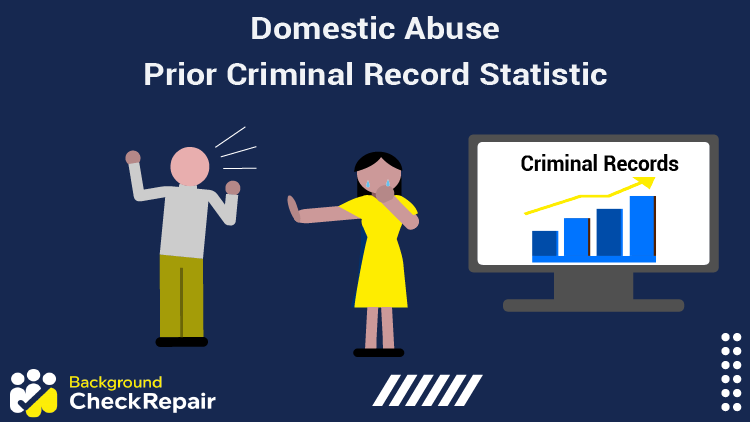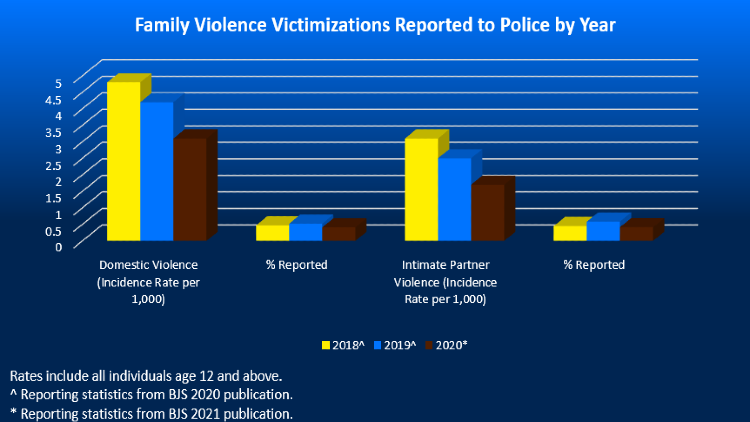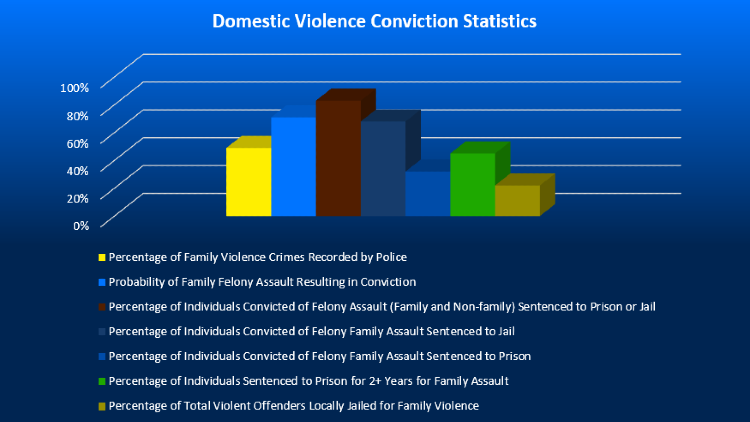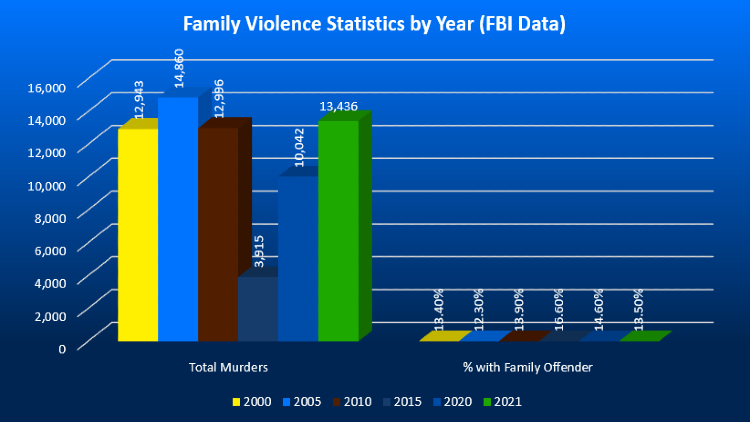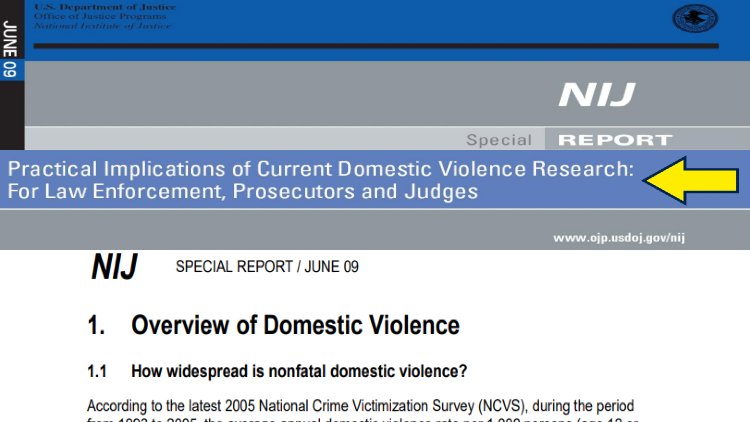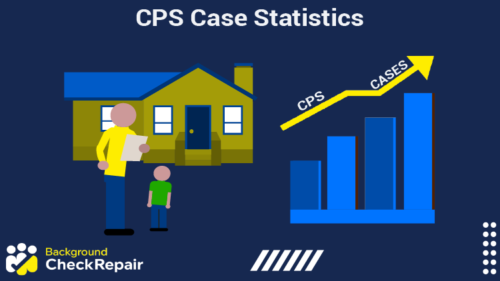1Carman, D. (2021, December 22). How Long Does Domestic Violence Stay On Your Record? Dan Carman Attorney at Law PLLC. Retrieved December 20, 2022, from <https://www.lexingtondefense.com/how-long-domestic-violence-on-record/>
2Chemaly, S. (2012, November 30). 50 Facts About Domestic Violence. HuffPost. Retrieved December 20, 2022, from <https://www.huffpost.com/entry/50-actual-facts-about-dom_b_2193904>
3Department of Justice. (2022). Domestic Violence. United States Department of Justice. Retrieved December 20, 2022, from <https://www.justice.gov/ovw/domestic-violence>
4Department of Justice. (2022, March 16). Justice Department Applauds Reauthorization of the Violence Against Women Act. The United States Department of Justice. Retrieved December 20, 2022, from <https://www.justice.gov/opa/pr/justice-department-applauds-reauthorization-violence-against-women-act#>
5DomesticShelters.org. (2015, January 7). Demographics and Domestic Violence. DomesticShelters.org. Retrieved December 20, 2022, from <https://www.domesticshelters.org/resources/statistics/demographics-and-domestic-violence>
6Durose, M., Wolf Harlow, C., Langan, P., Motivans, M., Rantala, R., & Smith, E. (2005, June). Family Violence Statistics. Bureau of Justice Statistics. Retrieved December 20, 2022, from <https://bjs.ojp.gov/content/pub/pdf/fvs07.pdf>
7Erez, E. (2002, January 31). Domestic Violence and the Criminal Justice System: An Overview [Medical Journal]. OJIN. Retrieved December 20, 2022, from <https://ojin.nursingworld.org/table-of-contents/volume-7-2002/number-1-january-2002/domestic-violence-and-criminal-justice/>
8FBI National Press Office. (2021, December 6). FBI Releases 2020 Incident-Based (NIBRS) Data. Federal Bureau of Investigation. Retrieved December 20, 2022, from <https://www.fbi.gov/news/press-releases/press-releases/fbi-releases-2020-incident-based-data>
9Glaun, D. (2021, June 2). A Handful of States Fueled a National Increase in Domestic Violence Shooting Deaths as COVID-19 Spread. PBS. Retrieved December 20, 2022, from <https://www.pbs.org/wgbh/frontline/article/national-increase-domestic-violence-shooting-deaths-during-covid-19/>
10Hamby, S. (2014, October 1). Guess How Many Domestic Violence Offenders Go to Jail. Psychology Today. Retrieved December 20, 2022, from <https://www.psychologytoday.com/us/blog/the-web-violence/201410/guess-how-many-domestic-violence-offenders-go-jail>
11International Association of Chiefs of Police. (2019, April). Domestic Violence [Model Policy]. International Association of Chiefs of Police. Retrieved December 20, 2022, from <https://www.theiacp.org/sites/default/files/2021-07/Domestic%20Violence%20FULL%20-%2006292020.pdf>
12Klein, A. (2009, June). Practical Implications of Current Domestic Violence Research: For Law Enforcement, Prosecutors and Judges [Special Report]. National Institute of Justice. Retrieved December 20, 2022, from <https://www.ojp.gov/pdffiles1/nij/225722.pdf>
13Kraut Law Group Criminal & DUI Lawyers. (2022). Domestic Violence Arrest and Investigation Process. Kraut Law Group Criminal & DUI Lawyers. Retrieved December 20, 2022, from <https://www.losangelescriminallawyer.pro/domestic-violence-arrest-and-investigation-process.html>
14Leemis, R., Friar, N., Khatiwada, S., & Chen, M. (2022, October). 2016/2017 Report on Intimate Partner Violence [The National Intimate Partner and Sexual Violence Survey]. Center for Disease Control and Prevention. Retrieved December 20, 2022, from <https://www.cdc.gov/violenceprevention/pdf/nisvs/NISVSReportonIPV_2022.pdf>
15Moorer, O. (2021, January 5). Intimate Partner Violence Vs. Domestic Violence. YWCA Spokane. Retrieved December 20, 2022, from <https://ywcaspokane.org/what-is-intimate-partner-domestic-violence/>
16National District Attorneys Association. (2017, July 17). National Domestic Violence Prosecution [Best Practices Guide]. National District Attorneys Association. Retrieved December 20, 2022, from <https://ndaa.org/wp-content/uploads/NDAA-DV-White-Paper-FINAL-revised-June-23-2020-1.pdf>
17National Domestic Violence Hotline. (2022). Domestic Violence Statistics. National Domestic Violence Hotline. Retrieved December 20, 2022, from <https://www.thehotline.org/stakeholders/domestic-violence-statistics/>
18National Institute of Justice. (2007, October 23). Overview of Intimate Partner Violence. National Institute of Justice. Retrieved December 20, 2022, from <https://nij.ojp.gov/topics/articles/overview-intimate-partner-violence>
19SafeHouseAlliance.org. (2022). 10 Things To Know When Considering A Civil Protection Order:. SafeHouseAlliance.org. Retrieved December 20, 2022, from <https://www.safehousealliance.org/wp-content/uploads/2012/10/10-Things-To-Know-When-Considering-A-Civil-Protection-Order-English.pdf>
20Shouse California Law Group. (2022, August 11). Is Domestic Violence a Felony? Shouse California Law Group. Retrieved December 20, 2022, from <https://www.shouselaw.com/ca/blog/is-domestic-violence-a-felony/>
21Shouse California Law Group. (2022, August 24). Are Restraining Orders a Public Record? Shouse California Law Group. Retrieved December 20, 2022, from <https://www.shouselaw.com/ca/blog/are-restraining-orders-public-record/>
22Smith, E., Durose, M., & Langan, P. (2008, February). State Court Processing of Domestic Violence Cases [Special Report]. Bureau of Justice Statistics. Retrieved December 20, 2022, from <https://bjs.ojp.gov/content/pub/pdf/scpdvc.pdf>
23Tecco, H. (2020, November 24). Domestic Violence in 2020 America. Medium. Retrieved December 20, 2022, from <https://halletecco.medium.com/domestic-violence-in-2020-america-8ef13d1a445b>
24Thompson, A., & Tapp, S. (2022, September). Criminal Victimization, 2021 [Bulletin]. U.S. Department of Justice. Retrieved December 20, 2022, from <https://bjs.ojp.gov/content/pub/pdf/cv21.pdf>
25Truman, J., & Morgan, R. (2014, April). Nonfatal Domestic Violence, 2003–2012 [Special Report]. Bureau of Justice Statistics. Retrieved December 20, 2022, from <https://bjs.ojp.gov/content/pub/pdf/ndv0312.pdf>
26United Nations Office on Drugs and Crime. (2021, November). Killings of women and girls by their intimate partner or other family members [Global estimates 2020]. UNODC. Retrieved December 20, 2022, from <https://www.unodc.org/documents/data-and-analysis/statistics/crime/UN_BriefFem_251121.pdf>
27USA Facts. (2021, October 21). Data Says Domestic Violence Incidents are Down, But Half of all Victims Don’t Report to Police. USA Facts. Retrieved December 20, 2022, from <https://usafacts.org/articles/data-says-domestic-violence-incidents-are-down-but-half-of-all-victims-dont-report-to-police/>
28World Population Review. (2022). Domestic Violence by State 2022. World Population Review. Retrieved December 20, 2022, from <https://worldpopulationreview.com/state-rankings/domestic-violence-by-state>
29Breiding, M.J., Chen, J., & Black, M.C. (2014, February). Intimate Partner Violence in the United States — 2010. Centers for Disease Control and Prevention. Retrieved January 4, 2023, from <https://www.cdc.gov/violenceprevention/pdf/cdc_nisvs_ipv_report_2013_v17_single_a.pdf>
30Brotsos, H., Harrell, E., Morgan, R., Thompson, A., Truman, J., & Tapp, S. (2021). National Crime Victimization Survey (NCVS). Office of Justice Programs. Retrieved January 4, 2023, from <https://bjs.ojp.gov/data-collection/ncvs>
31Department of Health & Human Services. (2023). CDC 24/7: Saving Lives, Protecting People. Centers for Disease Control and Prevention. Retrieved January 4, 2023, from <https://www.cdc.gov>
32Federal Bureau of Investigation. (2023). National Incident-Based Reporting System (NIBRS). Federal Bureau of Investigation. Retrieved January 4, 2023, from <https://www.fbi.gov/how-we-can-help-you/more-fbi-services-and-information/ucr/nibrs>
33Federal Bureau of Investigation Crime Data Explorer. (2023). Federal Bureau of Investigation Crime Data Explorer. Federal Bureau of Investigation Crime Data Explorer. Retrieved January 4, 2023, from <https://cde.ucr.cjis.gov/LATEST/webapp/#/pages/home>
34Morgan, R. E., & Truman, J. L. (2020, September). Criminal Victimization, 2019. Bureau of Justice Statistics. Retrieved January 4, 2023, from <https://bjs.ojp.gov/content/pub/pdf/cv19.pdf>
35National Coalition Against Domestic Violence. (2023). State-by-State. National Coalition Against Domestic Violence. Retrieved January 4, 2023, from <https://ncadv.org/state-by-state>
36National Institute of Justice. (2016, March 7-8). The Criminal Justice System Response to Intimate Partner Violence Victims: Developing a Research Agenda. Office of Justice Programs. Retrieved January 4, 2023, from <https://www.ojp.gov/pdffiles1/nij/249907.pdf>
37Peek-Asa, C., Anne, A., Harland, K., Beyer, K., Dickey, P., & Saftlas, A. (2011, November). Rural Disparity in Domestic Violence Prevalence and Access to Resources. J Womens Health (Larchmt). Retrieved January 4, 2023, from <https://www.ncbi.nlm.nih.gov/pmc/articles/PMC3216064/>
38Smith, S. G., Chen, J., Basile, K. C., Gilbert, L. K., Merrick, M. T., Patel, N., Walling, M., & Jain, A. (2017, April). The National Intimate Partner and Sexual Violence Survey (NISVS): 2010-2012 State Report. Centers for Disease Control and Prevention. Retrieved January 4, 2023, from <https://www.cdc.gov/violenceprevention/pdf/NISVS-StateReportBook.pdf>
39Smith, S. G., Zhang, X., Basile, K. C., Merrick, M. T., Wang, J., Kresnow, M., & Chen, J. (2018, November). The National Intimate Partner and Sexual Violence Survey: 2015 Data Brief – Updated Release. Centers for Disease Control and Prevention. Retrieved January 4, 2023, from <https://www.cdc.gov/violenceprevention/pdf/2015data-brief508.pdf>
40United States Government. (2023). Factsheet: The Violence Against Women Act. Whitehouse.gov. Retrieved January 4, 2023, from <https://obamawhitehouse.archives.gov/sites/default/files/docs/vawa_factsheet.pdf>
41United States Government. (2023). State Social Service Agencies. USA.gov. Retrieved January 4, 2023, from <https://www.usa.gov/state-social-services>
42US Congress. (2022, May 24). H.R.1620 – Violence Against Women Act Reauthorization Act of 2021. Congress.gov. Retrieved January 4, 2023, from <https://www.congress.gov/bill/117th-congress/house-bill/1620/text>
43US Department of Health & Human Services. (2022, December 19). About CDC’s Injury Center. Centers for Disease Control and Prevention. Retrieved January 4, 2023, from <https://www.cdc.gov/injury/about/index.html>
44US Department of Health & Human Services. (2023). Reports and Publications. Centers for Disease Control and Prevention. Retrieved January 4, 2023, from <https://www.cdc.gov/violenceprevention/datasources/nisvs/summaryreports.html>
45US Department of Justice. (2023). Action Center. US Department of Justice. Retrieved January 4, 2023, from <https://www.justice.gov/>
46US Department of Justice. (2023). Improving Law Enforcement Response to Sexual Assault and Domestic Violence by Identifying and Preventing Gender Bias. US Department of Justice. Retrieved January 4, 2023, from <https://www.justice.gov/ovw/page/file/1509451/download>
47Walters, M. L., Chen, J., & Breiding, M. J. (2013, January). The National Intimate Partner and Sexual Violence Survey (NISVS): 2010 Findings on Victimization by Sexual Orientation. Centers for Disease Control and Prevention. Retrieved January 4, 2023, from <https://www.cdc.gov/violenceprevention/pdf/nisvs_sofindings.pdf>


